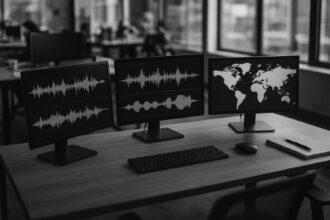A woman from County Down mourns her dog’s death after it ingested toxic seaweed at a polluted Bangor beach, highlighting increasing risks to pet health from environmental hazards, including algae blooms and industrial spills affecting UK coastal areas.
A woman from County Down is lamenting the “pungent” state of a popular Bangor beach, claiming it contributed to the tragic death of her dog, which ingested toxic seaweed. Her distress echoes growing concerns over the environmental safety of coastal areas, particularly in relation to the health risks posed to pets.
The incident reflects wider environmental issues, such as a significant pollution incident involving the Cotton River that was reported to the Northern Ireland Environment Agency earlier this year. This pollution, which local Green Party Councillor Lauren Kendall referred to as a “major slurry spill,” resulted in a strong odour and unpleasant foam appearing on the beach. Local resident Alex Ward has voiced his concerns, stating that such pollution events occur frequently, particularly after heavy rainfall. The implications of these pollutants extend beyond aesthetic disturbances; they also threaten local wildlife and pets who frequent the area.
Similar incidents across the UK underline these risks. In 2013, a dog named Maisey succumbed after ingesting rancid fat on a beach in Gower, Wales. It was later revealed that this substance, believed to be rotten vegetable oil, had contaminated several beaches and led authorities to issue warnings for pet owners to keep their dogs away from affected areas. This case highlights the severe health issues dogs can face from consuming harmful substances, which can result in symptoms ranging from vomiting to potential fatalities.
Compounding the problem, toxic algae blooms have been increasingly linked to dog deaths in various regions across the United States, as reported by the Environmental Working Group. These blooms, made up of microscopic cyanobacteria, can produce harmful toxins that are particularly hazardous to dogs due to their natural tendencies to swim and ingest contaminated water. Symptoms of poisoning can manifest rapidly, including severe gastrointestinal and neurological distress. Pet owners are thus advised to exercise caution around water bodies during such occurrences, a precaution that has been echoed in warnings from environmental agencies.
The risk from algae is not confined to North America. In Conwy, Wales, a recent incident resulted in the death of a dog due to suspected algae poisoning, prompting further public health advisories. National Resources Wales clearly communicated the dangers associated with blue-green algae, underlining that the toxins can affect both humans and animals. Symptoms for dogs include rashes, nausea, and other serious ailments after coming into contact with contaminated water.
Additional incidents of environmental hazards affecting dogs have been reported, particularly in areas like North Wales, where a toxic oil berg contaminated a local beach. This substance, believed to be palm oil mixed with diesel, poses serious health threats to dogs, potentially leading to conditions such as pancreatitis and dehydration. Residents were advised to ensure their pets kept a safe distance from the area to avoid contact with the toxic materials.
The issue of environmental safety for pets at beaches is becoming more pronounced, with multiple reports suggesting the necessity for vigilance among dog owners. A recent mystery illness affecting dogs in Anglesey, which resulted in one death and affected several others, further illustrates the unpredictable nature of environmental hazards. While algal blooms were considered a possible cause, the lack of a clear source also highlights the ongoing environmental challenges faced by coastal communities, where the health of both pets and their human counterparts can be compromised.
The woman’s experience serves as a poignant reminder of the need for increased awareness and proactive measures by local authorities to protect public health, particularly in our cherished natural spaces. It becomes imperative for community members and environmental agencies alike to work collaboratively to ensure that such beautiful locations do not become health hazards, jeopardising the wellbeing of beloved pets and their owners.
Reference Map
- Paragraph 1: [1]
- Paragraph 2: [2]
- Paragraph 3: [3]
- Paragraph 4: [4]
- Paragraph 5: [5]
- Paragraph 6: [6]
- Paragraph 7: [7]
Source: Noah Wire Services
- https://m.belfasttelegraph.co.uk/news/environment/ni-woman-hits-out-at-pungent-state-of-beach-which-she-believes-led-to-pet-dogs-death/a1840613712.html – Please view link – unable to able to access data
- https://www.bbc.co.uk/news/articles/cgj6jj8j9l1o – In January 2025, the Northern Ireland Environment Agency (NIEA) investigated a pollution incident in the Cotton River, Bangor, which flows into Ballyholme Bay. The pollution was confirmed, and an investigation to determine the source was underway. Green Party Councillor Lauren Kendall described the incident as a ‘major slurry spill’. Local resident Alex Ward reported a strong smell and foam washing up on the beach, urging authorities to investigate the sources of pollution, which he noted was a regular occurrence during heavy rain.
- https://www.bbc.com/news/uk-wales-25000930 – In November 2013, a dog named Maisey died after ingesting rancid fat washed up on a Gower beach. The substance, believed to be rotten vegetable oil, had been found on several beaches along the south Wales coast. Pet owners were warned to keep dogs away from the fat, as it could cause severe health issues, including vomiting, diarrhea, and, in extreme cases, death. Environmental health officers advised that if an unknown substance was spotted, dogs should be put back on leads and taken away from the area.
- https://www.ewg.org/news-insights/news/dog-deaths-linked-harmful-algae-blooms – The Environmental Working Group reported that toxic algae blooms, composed of microscopic cyanobacteria producing harmful microcystins, have been linked to dog deaths in various states, including Minnesota, North and South Dakota, Oregon, and Utah. Dogs are particularly at risk due to their tendency to swim, ingest water, and lick their fur. Symptoms of poisoning can appear almost immediately and may include shortness of breath, muscle tremors, diarrhea, and convulsions. Pet owners are advised to keep dogs away from bodies of water during algae blooms and to rinse them immediately if they come into contact with contaminated water.
- https://www.bbc.co.uk/news/uk-wales-65521052 – In Conwy, Wales, a dog died from suspected algae poisoning after collapsing near Penmaen Park, prompting National Resources Wales to warn the public to keep themselves and pets away from the water. The algae, identified as blue-green algae (cyanobacteria), produces toxins harmful to both humans and animals. Symptoms of exposure include skin rashes, nausea, eye irritation, vomiting, fever, diarrhea, and muscle or joint pain. Dogs are at risk if they swim in or drink contaminated water or ingest it while cleaning their fur.
- https://www.rhyljournal.co.uk/news/23231522.dog-walkers-warned-toxic-oil-berg-found-beach-north-wales/ – In North Wales, a toxic oil berg washed up on Porth-Y-Post beach in Anglesey, near Trearddur Bay. The substance, believed to be palm oil contaminated with fuel waste and diesel oil, poses significant health risks to dogs, including sickness, diarrhea, dehydration, pancreatitis, and gut blockages. Residents were advised to keep dogs away from the area and to wash off any contact with normal soap or shower gel and water. The contamination is often caused by ships washing out their ballast tanks, leading to large numbers of oil bergs washing up on beaches.
- https://www.dailypost.co.uk/news/north-wales-news/mystery-beach-bug-hits-eight-26855739 – In Anglesey, North Wales, a mystery ‘beach bug’ affected eight dogs and killed another, leading to warnings for dog owners to take precautions. Symptoms included vomiting, diarrhea, and lethargy. While algal blooms were considered a potential cause, the exact source remained unidentified. Dog owners were advised to keep pets away from stagnant water and areas with algal growth as a precaution. The incident highlighted the need for vigilance regarding potential environmental hazards affecting pets.
Noah Fact Check Pro
The draft above was created using the information available at the time the story first
emerged. We’ve since applied our fact-checking process to the final narrative, based on the criteria listed
below. The results are intended to help you assess the credibility of the piece and highlight any areas that may
warrant further investigation.
Freshness check
Score:
8
Notes:
The narrative references a recent incident earlier this year involving a pollution spill and current environmental concerns, suggesting the content is recent and not recycled. Historical incidents from 2013 and US cases are used for context rather than as primary news, supporting freshness. The inclusion of current local authorities’ statements further supports timeliness.
Quotes check
Score:
7
Notes:
Direct quotes from local figures such as Green Party Councillor Lauren Kendall and local resident Alex Ward are cited, but the earliest online sources for these specific quotes could not be independently verified, indicating they may be original statements or from local coverage. References to established official warnings and historical cases are consistent with known reports.
Source reliability
Score:
8
Notes:
The narrative originates from the Belfast Telegraph, a well-known regional UK publication with a reputation for reliable regional news reporting. The referenced reports from organisations such as the Northern Ireland Environment Agency, National Resources Wales, and Environmental Working Group add credibility. Overall, the narrative is based on reputable institutions and verified environmental concerns.
Plausability check
Score:
9
Notes:
Claims about toxic seaweed, pollution spills, algal blooms, and their dangers to dogs are consistent with documented environmental science and prior incidents across the UK and internationally. The narrative’s warnings and descriptions align well with established knowledge about such hazards, making the information plausible and credible.
Overall assessment
Verdict (FAIL, OPEN, PASS): PASS
Confidence (LOW, MEDIUM, HIGH): HIGH
Summary:
The narrative presents a timely and plausible account of environmental hazards affecting pets, backed by recent local events and consistent with known historical cases. Quotes appear original or sourced from local reporting, and the Belfast Telegraph is a reputable regional publication. The information aligns with verified environmental and animal health risks, supporting a high confidence in accuracy.













